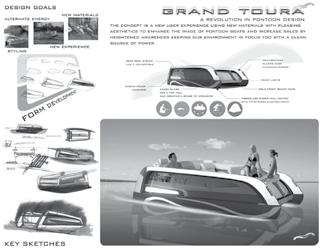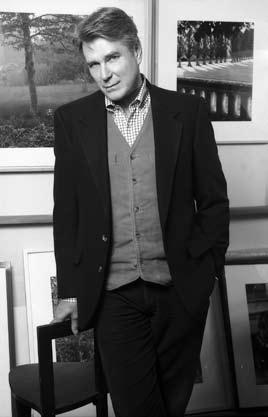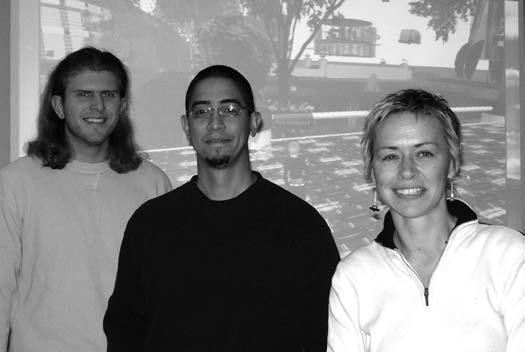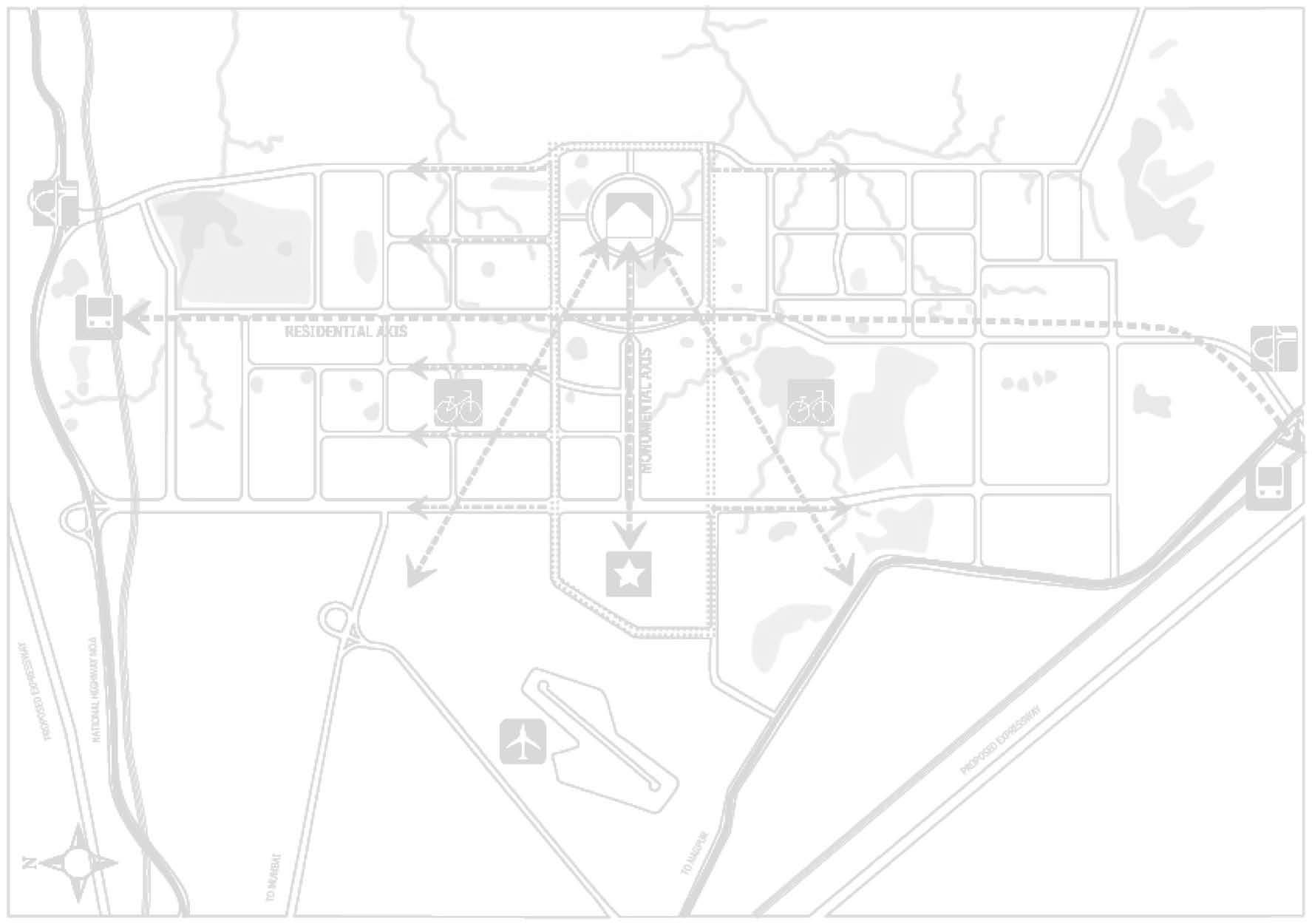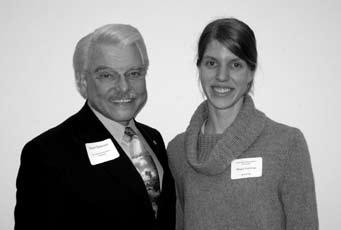
27 minute read
Achieve! The Campaign for NC State
Achieve ! The Campaign for NC St ate
As ofDecember 31, 2007, the College ofDesign is 96 percent toward its $9 million campaign goal. Thanks to the generosity ofalumni and friends ofthe college, we have just under $370,000 to raise by June 30, 2008, when the campaign comes to its official close. When we started this campaign six and a halfyears ago and the original goal of$4.5 million was set, many wondered how the college would be able to raise that sum ofmoney in six years. Then just three years into the campaign as the college was about to meet this goal early, the challenge was made to double the original goal to $9 million. Once again, alumni and friends helped the college rise to this challenge. So what have these millions ofdollars been used for and how does your support benefit the college and its students? The following is a list ofsome ofthe new funds and endowments that have been established since the Achieve! Campaign started in 2001. The net result ofthese new funds is: • More than $500,000 in new endowed scholarships and fellowships that along with the new annual awards generate more than $38,000+ in new scholarship and fellowship awards made to students each year. • More than $700,000 in new endowed lecture funds that will generate $28,000+ annually for special lectures and seminars. • More than $300,000 in new endowed international funds that will generate more than $13,000+ annually for student travel and study abroad. • More than $250,000 pledged to endow the Student Publication Fund that has re-established the college’s Student Publication plus an additional $250,000 planned gift to this fund. • $100,000 gift for the renovation ofthe entrance gallery for the auditorium in Kamphoefner Hall. • More than $3 million in pledged deferred gifts benefiting multiple departments within the college. • More than $100,000 in annual gifts made to special project funds each year.
Advertisement
2007/2008 Scholar ship and Fellowship Reception
On November 7, 2007, scholarship and fellowship recipients gathered with the donors of their awards in the rotunda of Brooks H all. This annual event gives the students the opportunity to thank their donors in person and allows the donors to see the work in the scholars’ studio. T his year more than 60 students received scholarships and fellowships totaling more than $75,000.
David Allen Scholarship Robert Roberson with Megan Casanega
Triangle Brick Scholarship Scott Mollenkopf, Ken H olland, and Ray Wells with recipients Maria Papiez and Kimberly Nelson
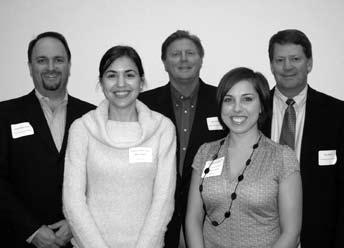
Boney Architects Scholarship Margaret Jamison with Charles Boney, Jr.

New Endowments L. Franklin Bost Industrial Design Fellowship Endowment Landscape Architecture Scholarship Endowment LS3P Scholarship Catherine S. & Herbert P. McKim Diversity Scholarship Endowment for Architecture O’Brien/AtkinsAssociatesFellowshipEndowment Leet Alexander O’Brien AIA Scholarship Wendy L. Olson Fellowship Enhancement Endowment for Public Service in Landscape Architecture Peterson Associates Scholarship Endowment Doug Westmoreland Scholarship Leazar Hall Design Fundamentals Scholarship (Building to Endowment) Claudia Gabaldón-Cotrim Landscape Architecture forInternationalStudents (Buildingto Endowment)
New Annual Awards AIA NC Eastern Section Scholarship AIA Piedmont Section Scholarship AIA Winston-Salem Scholarship CertainTeed Architectural Scholarship Design Dimension Scholarship Duda/Paine Architects Fellowship Etta Bea Scholarship Moseley Architects Fellowship NC Masonry Contractors Association Sigmon Memorial Scholarship Pumpkin King Scholarship Patrick Rand / CCMA Scholarship Roughton Nickelson De Luca Architects Scholarship Smith Sinnett Architecture Scholarship Technical Achievement in Industrial Design Scholarship from Tackle Design New Lecture and Seminar Funds: Robert P. Burns Memorial Fund Robert P. Burns Lectures and Seminars on Structural Innovations Endowment Eduardo Catalano EndowedLecture/Seminaron Innovations in Contemporary Architecture MacMillan Family Lectureship
New International Travel Awards: Abee Family Prague Institute Scholarship Barbara and George Malecha Prague Scholarship Fund Noble McDuffie Study Abroad Scholarship John Reuer Memorial Endowment
New Deferred Gifts: Anonymous –Scholarship for Industrial Design Douglas Brinkley Jane Fadum Linda Noble and CraigMcDuffie SherryO’Neal Gordon Schenck George Smart, Sr. Rayand Melba Sparrow BettyTrent and JeffreyBarger
New Special Project Funds: S. Aaron Allred Entrance GalleryFund The Advanced Media Lab Fund American Home Project ArchitectureBookFundinHonorofHenrySanoff Architecture FacultyDevelopment Endowment in Honor ofFormer FacultyMembers Art to Wear Fashion ShowFund Bio-fuel Compatible Diesel College ofDesign DiversityInitiative Fund ContemporaryArt Museum Initiative ofthe College ofDesign Design Professional Outreach Fund DesignResearchandEngagementFundforExcellence Enkeboll Foundation for Arts and Architecture Fund Home Environments Design Initiative Fund Natural LearningInitiative (NLI) Fund NLI Preschool Outdoor Environments Research Fund Prague Fund ResearchErgonomicsandDesign(RED) LabFund School ofArchitecture Publications Fund George Smart Special Studio Project Fund Student Publication Endowment Urban Design Studio Fund
It is not too late to be a par t of the Achieve! Campa ign and mak e a differ ence in the life of the college. Our goal is to go beyond the $9 million target and continue the moment ofgiving backthat this campaign has inspired and carryit into the 60th AnniversaryCelebration year for the college. Please contact Carla Abramczyk(see below) to discuss all ofthe giving opportunities that are available.
Supp or t the college Carla Abramczyk, Assistant Dean for External Relations and Development, can be contacted by phone at 919.513.4310 or E-mail at carla_abramczyk@ncsu.edu.
C o mm e nc e m e n t
Commencement Address by Gianfranco Zaccai NC State University College of Design, December 19, 2007
Zaccai was the recipient of an Honorary Doctorate at the University Commencement Ceremony. He is co-founder, president and CEO of Continuum, with offices in Boston, Milan, and Seoul.
Graduating Class of 2007, faculty, parents, family members, guests, and students ofthe North Carolina State University College ofDesign; it is an honor and a pleasure to speak to you today. A few years ago I had the pleasure to work with the Indian designer Ranjit Makkuni to develop an interactive exhibit on Mahatma Gandhi, the father ofIndian independence and the inspiration for such future leaders as Martin Luther King, Robert Kennedy, Nelson Mandela and Bishop Desmond Tutu. Gandhi wanted to unite the Indian people to end the British domination ofIndia by first ending the British monopoly on cloth manufacturing. As a result, he suggested that ifeach Indian spun his or her own thread and wove his or her own cloth there would be no more need for imported cloth in India. Gandhi, in fact, is often pictured spinning a charka, the traditional Indian spinning wheel, while speaking (as made indelible in our consciousness by the famous picture by Margaret Burke White). What this act symbolized was more than thread spinning. The charka was symbolic ofthe power ofan individual act leading to collective action.
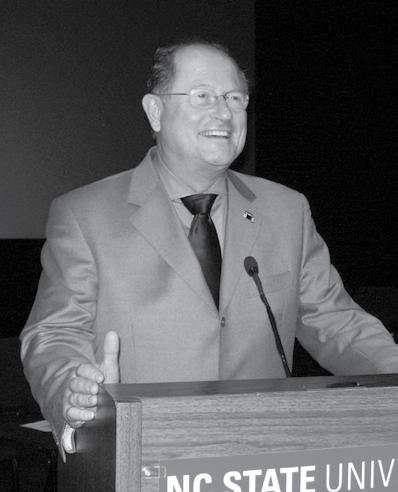
As a result, we decided to utilize the charka as an interface device in this exhibition. Two Charkas would be mounted on both sides of glass panels and an array ofthese would be in a room. Visitors could affect the images and sounds they would see and hear all around them by spinning each charka at various speeds and in different directions. The most interesting aspect ofthis interaction is that each charka communicates with all the others; thereby magnifying or canceling out the actions ofeach individual spinner. Our purpose was not only to create an interface between the visitor and the exhibition, but to provoke an interaction between and among people. In the exhibition, the charka is meant to be a vehicle by which each individual can sense their personal power to affect change and to demonstrate the power ofcollective action for both good and bad. Gandhi’s use ofthe charka represents, in the fullest sense, an act of design atthe grandestscale. A designed actthatcomes from understanding …the deep understanding ofhuman needs and aspirations, the understanding ofeconomic forces, and the understanding ofthe importance ofthe artifact as both a tool and a symbol. Most ofall, it represents the design ofan emotional and spiritual connection that speaks a universal language across the world. I think that ultimately our mission as designers is to spin our own creative charkas, not only for our own benefit, but also for the common good ofcountless others.
It is seductive to think ofourselves as the next great “Rock Star” designer or artist (and I certainly hope that each ofyou will achieve both great wealth and international fame). But is this what the world really needs? And will this give you all the personal satisfaction you seek in your lives and when you look back at the end ofyour careers? In all probability most ofyou will live in the less rarefied atmosphere that most designers work in. In fact, many ofyou may not even work in traditional design roles. But all ofyou will be designing your lives and influencing the lives ofcountless others. In all cases your goal should be to be truly “Renaissance” men and women at a time when a new Renaissance in our country and the world is sorely needed. I would like to suggest that another, earlier “Renaissance Person,” Leonardo DaVinci, still serves as a model for us. I do not say this because the bookThe DaVinci Code was popular—in fact I am not a fan ofthe book at all—rather, I prefer to quote Michael Gelb. The author ofa lesser known book DaVinci Decoded states that Leonardo DaVinci integrated in his life and his work essential guiding principles ofthe complete creative person. Although I may also question many ofGelb’s points, I believe that the following principles should be integrated into our daily lives and into our values as designers and as creative people ofintegrity:
1. Curiosita` (Curiosity) –Seek the Truth –An unrelenting quest for continuous life-long learning.
2. Dimostrazione (Demonstration) –Show Responsibility –A commitment to test knowledge through experience, persistence and a willingness to learn from mistakes.
3. Sensazione (Sensation) –Sharpened Awareness –The continued refinement ofthe senses. Leonardo noted that “the five senses are the ministers ofthe soul.”
4. Sfumatura (Blurring) –Engaging the Shadows –The willingness to embrace ambiguity, paradox, and uncertainty.
Dean's Awar d Winner “On occasion there are individuals who stand out among the graduating class for the extra life effort dedicated to accomplishing the goal ofgraduation. It is appropriate that we recognize this performance with the Dean’s award for outstanding College Citizenship and Academic Excellence. The painting of Natalia Goncherova depicting the good citizen angel Michael astride the Greek mythical creature Pegasus inspires this award known as Wings on Wings. This mixing ofsymbols reminds us that opportunity represented by Pegasus must be matched by the responsible behavior ofMichael. It is my pleasure to present the Dean’s Award ‘Wings on Wings’ to K.C. Kurtz who is graduating with a Master ofArchitecture Degree. K.C. served as a graduate teaching assistant with Wendy Redfield, Dona Stankus, Randy Lanou and I add with pleasure, myself. He was a member ofthe first team ofarchitecture students to work with Professor Georgia Bizios on the Lumbee Indian Affordable Housing project; and he was a member ofthe state and national sustainability design team from the School ofArchitecture that eventually won national recognition from the US Green Building Council. K.C. has represented the College ofDesign as a presenter at the NC State Sustainability Conference, the Central Carolina Community College Sustainability Fair, the Home Builders’ Association ofOrange, Chatham and Durham County’s Green Home Tour, and on UNC Radio’s ‘The State ofThings.’ He has also been interviewed for two articles in The News & Observer. While he has been active in many college programs he has also earned membership into the Tau Sigma Delta Honor Society. K.C. stands out by exhibiting his enthusiasm for design and for the college. Again, it is with great pleasure that I present K.C. with the Wings on Wings Dean’s Award.” —Dean J. Marvin Malecha K.C. Kurtz accepts the “Wings on Wings” Dean’s Award.
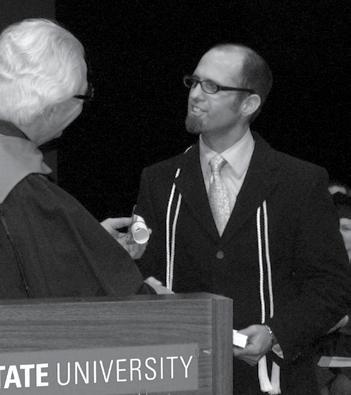
5. Arte/Scenza (Art/Science) –Cultivation ofBalance –The balance of left-right brain thinking culminating in whole brain thinking.
6. Corporalita` (Corporality) –Integration –The integration ofmind and body, the masculine and feminine, through the cultivation of grace, ambidexterity, fitness and poise.
7. Conessione (Connection) –Practice ofLove –A recognition and appreciation ofthe interconnectedness ofall things in this world and above.
To this I would add three others that I am quite confident Leonardo practiced:
8. Disciplina (Discipline) –Embrace constraints, they are your friends. Cost limitations, schedules, the limits oftechnical and scientific possibility, and the wishes ofpeople who are differentthan you (clients, collaborators, and end users) are not restrictions to creativity, they are the stimulus of creativity!
9. Eleganza (Elegance) –Don’t just design trendy land fill, seek to find the truly elegant solution. Do more with less. Seek to reduce needless features and material waste. Always seek to add humanity, wit, charm, and subtlety in all that you do.
And finally:
10. Obbligo (Obligation) –Remember what you were given: by your friends (and people who may not have seemed to be your friends at the time because they forced you to confront difficult issues), your family, and the North Carolina State University College ofDesign. Remember to give back each in your own way and to pass on what you have received to others.
Finally, I would ask you all to take these principles, interpret them in your own ways, and to go and spin your own design charkas. Be true to the Gandhian ideals ofindividual action and collective responsibility. Spin your dreams and turn them into action, and, most importantly, help others to discover and spin their own dreams!
Design Council Congra tulations “In just a few more minutes, you all seated here will become graduates ofthe College ofDesign. It is my official obligation to wish you all congratulations, but as a fellow student (for a little longer at least), it is also my personal privilege. You have made it. You have achieved the goal all design students aspire to from the moment we enter as freshmen. You have survived nearly one halfofa decade (and in some cases even longer) ofintensive studios, critical evaluations, and seemingly endless projects. And now, having made it through your FINAL final critiques, you sit before us in what I am sure can only be described as varying degrees ofshock. But whether or not you can fully appreciate this moment, my wish is that in the future you are able to look back on your time at the College ofDesign and feel that you truly have accomplished something great. None ofus here can be certain ofwhat the future may hold. The best we can do is face what is ahead armed with what we have learned in this place. And I’m not just talking about the abilities to develop the perfect concept or craft an immaculate model, however important those skills may be. Hopefully our experience here has taught us much more than just how to design and produce graphics, indoor experiences, outdoor spaces, products, and great works ofart. We also should have learned that as designers it is our job to go against the grain. We must think differently, fail gloriously, and always live inquisitively. Above all, the most important lesson we should take away from the College ofDesign is to constantly challenge what we are told, and to never stop asking questions. On the first day in my freshmen studio, a certain professor told my class we were only allowed to ask him one question the entire semester. Ofcourse, this in no way prevented us from asking many questions a day, but we always received the same answer: “Are you sure you want that to be your one question?” Inevitably, as true designers, we asked the questions, and we ended up answering them ourselves. I think that is what our professor was looking for us to do, and now, as you leave this place, it is what the world will be looking for you to do.” — Marie Fornaro, Design Council President
Dr. Bob Stipe Professor Emeritus ofLandscape Architecture Dr. Bob Stipe passed away Sunday, September 23, 2007. After several years as the principal planner at City & Town Planning Associates, he joined the UNC Institute ofGovernment as an Assistant Director from 1957 to 1974. He rose through the ranks from Instructor to Professor ofPublic Law and Government, specializing in planning, zoning, and historic preservation and conservation law. In 1974 and 1975 he served as Director ofthe North Carolina Division ofArchives and History and State Historic Preservation Officer. He joined the faculty ofthe Landscape Architecture Department in the School ofDesign at N.C. State University, where he was Professor ofDesign and taught courses in community design policy, historic preservation, and the legal aspects oflandscape and townscape conservation. Bob retired in 2002 after more than 44 years ofuniversity teaching, and was named Professor Emeritus ofDesign at the School ofDesign. However, in addition to very limited private consulting in the area ofhistoric preservation and preservation planning policy, he continued to teach part time at the School ofDesign and lecture widely around the United States and Central Europe. A former Senior Fulbright Research Fellow at University College, London University, in 1968-69, Dr. Stipe received the Secretary ofthe Interior’s Distinguished Conservation Service Award in 1978. He is a Trustee Emeritus ofthe National Trust for Historic Preservation, and in 1987 he was elected a Fellow ofthe United States Committee ofthe International Council on Monuments and Sites, a UNESCO organization based in Paris, France. He was the editor of A Richer Heritage published by the UNC Press in 2003 and author ofseveral chapters in that book. He was the editor ofa series ofvolumes on historic preservation in ten other countries. During his long career he had been the principal draftsman ofNorth Carolina’s preservation legislation and had authored more than 100 articles and publications about planning and historic preservation and had produced several films in these areas. In 1988 he was awarded the Louise DuPont Crowninshield Award by the National Trust for Historic Preservation, the Trust’s highest award for a lifetime ofsuperlative achievement in the field ofhistoric preservation. He was a member ofthe Cosmos Club, Washington, D.C., and had been awarded honorary distinguished memberships in a number ofnational and international preservation organizations.
John Charles Brown (B.Arch. 1968) John Charles Brown, 63, passed away on Sunday, January 27, 2008 at NC Memorial Hospital in Chapel Hill. John was a native ofNorfolk, Va., and graduated from NC State University in 1968. He practiced architecture in Charlotte and Raleigh. He began with Odell Associates, Inc. and later joined the firm ofPeterson-Clary, Inc. Subsequently he became a partner in Peterson Associates, Inc., ofwhich he was a Vice-President. He headed the Raleigh office ofPeterson Associates before becoming a founding partner in BJAC, P.A., of Raleigh in 1994. Illness forced him to retire in 2003. His major clients included Stanly Regional Medical Center, Rex Hospital, NC Memorial Hospital, and Maria Parham Hospital. He was a member ofthe American Institute ofArchitects.
Bradley Ward Davis (BLA 1971; MLA 1978) Bradley Ward Davis, 59, ofCharlotte, passed on Wednesday, December 5, 2007 at his residence. He was born on September 17, 1948 in Washington, D.C., to the late Wallace B. and Dorothy Heitritter Davis. He was a partner with LandDesign since 1979. He served as president ofthe company from 2001-2006. The firm has 230 employees in six offices domestically and an office in Beijing, China. Davis was Partner-in-Charge ofthe Charlotte office. His services included directing design and planning, project administration, and management. Throughout his career, he focused on urban design and comprehensive master planning, and in particular, the development oftown and community plans which synthesize growth and environmental objectives. Davis served on service organizations and task forces including the Governors Commission on Smart Growth, Urban Land Institute Smart Growth Committee, Voices and Choices Land Use Action Team, Charlotte 2015 Task Force, the Mecklenburg County Parks and Recreation Commission, and the Charlotte Urban Forum. Davis was awarded the NCASLA North Carolina Award in 2006 “in recognition ofa career ofachievement, leadership, and service at the highest level by a professional who has statewide stature and has made a lifetime contribution to the profession oflandscape architecture.” Memorial donations in memory ofBradley W. Davis may be made to NC State Foundation College ofDesign Campus, Box 7701, Raleigh, NC 27695-7701.
Correction: The Fall 2007 Design Influence listed the degree and graduation date of the wrong W.B. Griffin. Mr. Griffin received a Bachelor in Architecture degree from NC State in 1942. [Sincere apologies to Billy Griffin (BPD 1969).]
C O L L EGE
Celebrate the 60th Anniversary of the NC State University College of Design Reconnect. Remember what it felt like to discover design. Find old friends. Meet new ones. See what students are doing now. Learn about the future of design. Have fun. Kicking offwith the 11th annual Design Guild Award Dinner on April 12, 2008, the year-long 60th anniversarycelebration will feature alumni receptions, exhibitions, lectures, tours and more, wrapping up with reunion weekend, April 3-6, 2009. Stay tuned: www.design.ncsu.edu/60. The 60th anniversarycelebration ofevents is overseen bya dedicated executive committee ofalumni volunteers: • Walt Teague (M.Arch. 1989) –Executive Chair –TFF Architects & Planners, LLP • Chuck Flink (BEDL 1982) –Greenways Incorporated • Barbara Wiedemann (MPD 1991) –Barbara Wiedemann Design Inc. • GuyMarshall (BEDP 1990) –Hawk Blade Studios, LLC • TracySpencer (BAD 2004) –Empire Properties • Sean Hilliard (MID 2007) –Tackle Design, Inc. • Kristen Hess (BEDA 1996) –HH Architecture
Ifyou are interested in volunteering to help contact your fellow alumni to tell them about 60th anniversaryactivities, please let us know! E-mail design@ncsu.edu. Want to make sure you hear up-to-date news about anniversaryevents? Send the college your latest contact information and sign up for DESIGNlife at www.design.ncsu.edu/enews_subscribe.html.
N E W S
International Design Competition Narrows Field to 10 Winners Including Two with NC State Connections Two ofthe 10 winners ofthe Design Competition “What ifNew York City...”, sponsored by the New York City Office ofEmergency Management, have connections to NCState University’s College ofDesign. The award-winning design teams are faculty member and alumnus David Hill and team members Laura Garófalo (associate professor), Nelson Tang (alumnus), Henry Newell (alumnus), Megan Casanega (graduate student), and alumni Darrel Mayer and Elizabeth Kolepp-Mayer. To view designs, visit www.nyc.gov/html/whatifnyc/html/ home/home.shtml. The competition asked for submissions that design post-disaster reliefhousing in the event that a Category 3 Hurricane makes land-fall in the city. The winners enter into a contract with New York Cityto further develop landscape and housingdesign proposals. Each winner receives a $10,000 prize.
College of Design Reception in New Bern The firm ofMaune Belangia FaulkenberryArchitects, PA, hosted the College ofDesign’s alumni reception in its beautifully renovated offices during the AIA North Carolina design conference held in New Bern last September.
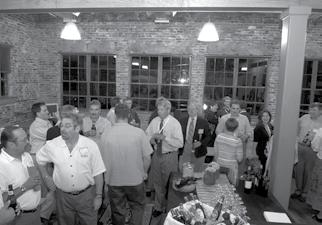

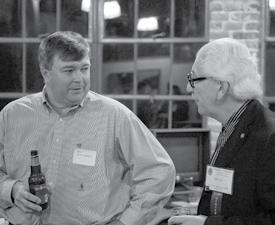
Left to right: Reception; Paul Boney and Jay Peterson; Randy Croxton and Fran Drummond; Dean Marvin Malecha speaks with reception host Bill Faulkenberry.
Marbles Kids Museum and the College of Design Team Up On September 29, 2007, a new partnership between Marbles Kids Museum and the College ofDesign was announced during the ribbon-cutting celebration for the new museum. Marbles was created through the merger oftwo existing children’s museums, Exploris and Playspace. The college’s relationship with Marbles will be coordinated through CAM (Contemporary Art Museum) using faculty and students as resources for developing collaborative programs and exhibits. Faculty and students were involved in brain storming ideas for a hands-on creativity and innovation exhibit that opened in February 2008. CAM staffis developing a summer design camp for middle school students that will be housed at Marbles in July 2008. The partnership between Marbles and the College ofDesign will open up valuable opportunities for students to serve as volunteers, interns, designers and “play partners” on the floor and behind the scenes ofthe museum. In addition, this relationship expands CAM and the College ofDesign’s K-12 art and design initiative.
DesignIntelligence Magazine Ranks Several College of Design Programs Several College ofDesign programs earned accolades in the November/December 2007 issue of DesignIntelligence. The Industrial Design undergraduate and graduate programs were listed in the top 15 programs; the Landscape Architecture graduate program was ranked in the top 20; and the undergraduate Architecture program was ranked in the top 20 programs. Dean Marvin J. Malecha was selected as one of DI’s 25 Most Admired Educators of2008.
Urba n Gr owth : Intelligent by Design – Sustainab le Models for Developm ent
The College ofDesign, in collaboration with the Raleigh Department ofCity Planning and supported by the NC State Foundation, held its 5th annual urban design conference on March 1 at downtown Raleigh’s Cardinal Club. Almost 200 participants, including designers, city officials and students and faculty members, learned about sustainable models, strategies and practical information for the planning, design, development and building needed to accommodate urban growth. Featured speakers included Bill Struever, Founder, CEO and President ofStruever Brothers Eccles & Rouse (developers ofDurham’s American Tobacco Historic District); Steve Schuster, AIA, ofClearscapes; Mitchell Silver, AICP, Director of Raleigh Department ofCity Planning; Heather L. Venhaus ofLadybird Johnson Wildflower Center and Jose Almiñana ofAndropogon, both representing the Sustainable Sites Initiative; and William F. “Bill” Hunt, Ph.D., PE, NC State University Biological and Agricultural Engineering/Stormwater Engineering Group.

Supporter US Green Building Council NC Triangle Chapter
Patrons AIA Triangle Cherokee ColeJenest & Stone Empire Properties Kimley Horn & Associates/Urban Resource Group North Carolina American Society of Landscape Architects Pearce Brinkley Cease + Lee
Contributors Adams Products Company Clancy & Theys JDavis Architects KlingStubbins
Gr owing in Place In concert with the urban design conference, College ofDesign’s Natural Learning Initiative presented “Growing in Place,” a symposium on planning and design for urban families, held at the Marbles Kids Museum on February 29, 2008. Symposium speakers included: Dan Douglas, MCP, Director ofthe Raleigh Urban Design Center; Sally Edwards, President and CEO ofMarbles Kids Museum; Professor Robin Moore, Director ofthe Natural Learning Initiative; Russ Stephenson, AIA, Raleigh City Council Member; and Rodney Swink, FASLA, Director ofthe North Carolina Office ofUrban Development. The John Rex Endowment was the major sponsor ofthe symposium. The Raleigh Department ofCity Planning and the Marbles Kids Museum also sponsored the event.
College of Design and the American Architectural Foundation Host School Design Institute The College ofDesign, in partnership with the American Architectural Foundation, hosted the Great Schools by Design Institute on October 28- 30, 2007, at the Friday Institute for Educational Innovation located on Centennial Campus. The seven school districts from North Carolina and Virginia that were present at the School Design Institute were the Wake County Public School System, Johnston County Schools, Winston-Salem/ Forsyth County Schools, Guilford County Schools, Richmond Public Schools, Albemarle County Public Schools, and the Williamsburg-James City County Public Schools. During the event, school district leaders collaborated with nationally known school design experts and College ofDesign faculty members to discuss challenges and critical school development issues in the Southeast region. The results ofthe School Design Institute will be published in a report that will detail recommendations and an array ofgood school design ideas. The event was sponsored by Target Corporation and co-sponsored by the William and Ida Friday Institute for Educational Innovation.
Home Environments Design Initiative (HEDI ) provides design consultation The Home Environments Design Initiative (HEDI) is providing design consultation to Our Children’s Place, a local non-profit. Our Children’s Place is a residential initiative allowing young children (babies and preschoolers) to live with their mothers while the women serve out their sentences for non-violent offenses. The program will be housed in an existing building, Deerfield Cottage, in Butner, N.C. HEDI research assistants Michael DeMonaco and Jon Hindman built a presentation model to be used by the non-profit for fundraising and community awareness events. The architect ofrecord for the building renovation will be Angerio Design.
Designer s, engineer s team up on high-tech ar t by Nate deGraff, Engineering Communications
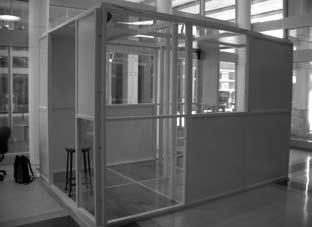
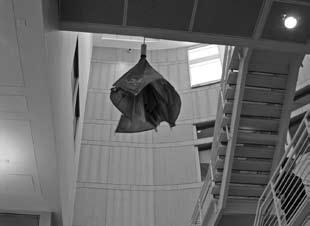
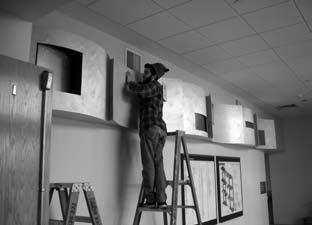
Take 11 designers and four engineers, throw in some sensors and a whole lot ofcreativity, and what do you get? Campus art that moves, talks and lights up—all at a visitor’s command. Students in design and electrical and computerengineeringatNorth CarolinaState Universityteamed up this fallto createthreeinteractiveartinstallations foroneoftheuniversity’s newestbuildings. Theartworkwas unveiled December17 in the westatrium ofEngineeringBuildingII on the university’s Centennial Campus. One installation, dubbed “Mr. Sound,” is an experimental theater that lets the audience play an active role. Sensors connected to floor panels and poles detect when visitors are touching them, triggering individual sound tracks created by the students. The resultis achorus ofsounds thatcan be manipulated bythe visitor. Another piece is a series ofumbrella-like fans lining a staircase. Sensors detect when visitors begin climbing the stairs, telling the fans to begin spinning as the visitors approach them. Students named it “Scyphozoa (skih-foh-ZOH-ay) volubilis.” The third installation senses when visitors come in one part ofthe building, prompting wood panels on an adjacent wall to open and close depending on how many people have entered the space. The panels display a blue light. The artwork is called “Wax and Wane.” The students worked all semester on the project, weathering many late nights to finish it in time. “In the end, they were extremely happy to be part ofthis unique experience,” said Mehmet Ozturk, a professor ofelectrical and computer engineering who advised the engineering students with Alex Dean, associate professor in the same department. Dana Raymond, associate professor ofart and design, advised the design students. The building that houses the artwork, Engineering Building II, opened in fall of2005. The design students are Jenna Bost, Lauren Deans, Enrique Dominguez, Julianne Gonski, Will Hagna, Dana Hartweg, Miles Holst, Maddie Langley, Lauren Pegram, Morgan Spiveyand Andrea Stroud. The engineering students who worked on the project are Eric Aumiller, Jason Frankie, Richard Jankovics and George Platica.
Engineering building II art installations (top to bottom): “Mr. Sound”; “Scyphozoa”; “Wax and Wane”.
by Kim Weiss Histor ic Initiative Results In La ndmark Comm itment to Sustainab ility
In an unprecedented initiative, the North Carolina component ofthe American Institute ofArchitects (AIA-NC ) announced in November 2007 that it would hold a design competition to select the architect for its new headquarters building on a high-profile site in downtown Raleigh. In all 50 states, an AIA component has never built its own headquarters from the ground up, so conducting a competition to select the designer “was the obvious and only solution,” said David Crawford, executive vice president ofAIA-NC . What made the competition more profound, however, was the understanding that this 12,000-square-foot building, representing a $4.5 million investment by AIA-NC , “will be our testament to sustainable architecture, the built environment, and the role ofarchitects in this endeavor,” said Walt Teague, immediate past president ofAIA-NC . Crawford added that the organization “made it a goal to use [the] new facilities to teach the public about what it means to design with the environment and future in mind.” Architects who entered the competition understood that the headquarters was to be designed to meet both LEED® (Leadership in Energy and Environmental Design) standards and AIA’s COTE (Committee On The Environment) objectives, which address appropriateness to the region, land use and site ecology, sustainable materials and methods ofconstruction, water usage, and energy efficiency. On January 23, the jury ofesteemed architects from across the nation

completed its deliberation ofthe 48 projects entered and announced that Frank Harmon Architect PA ofRaleigh had won First Place with a proposal that they praised for being “ofits place,” for making good use ofa difficult site, for integrating sustainable design principles rather than using them as applique, and for “embracing the community.” Second place went to Pearce, Brinkley, Case + Lee, PA ofRaleigh, and third place went to Kenneth E. Hobgood, Architects, also ofRaleigh. According to Frank Harmon, FAIA, principal, his firm’s design “aspires to become a role model for healthy urbanism, both for chapter members and future development in downtown Raleigh.” He pointed out that the previous AIA-NC headquarters did this in its time by adaptively re-using an historic structure: an old water tower also in the downtown area. “The new headquarters faces a 21st Century challenge, however,” he said, “which is the global necessity to conserve and protect our natural resources.” William McMinn, FAIA, Dean Emeritus ofCornell University’s College of Architecture selected the judges for the competition. They were: Daniel Bennett, FAIA, Dean ofthe College ofArchitecture at Auburn University; Allison Ewing, AIA, LEED® AP, a partner in Hayes + Ewing Design in Charlottesville, Va.; David Lee, FAIA, partner in Stull & Lee, Boston; and jury chair Susan Maxman, FAIA, founder and design principal ofSMP Architects in Philadelphia. Drawings ofall the winning design may be seen at www.aianc.org.

